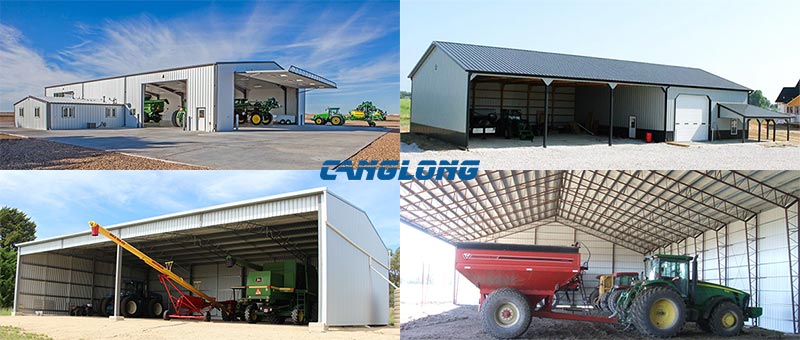Farm Equipment Storage Building
| PRODUCT PARAMETER | |
|---|---|
| Place of Origin: | Henan, China (Mainland) |
| Standard: | GB Standard, EU Standard, ASTM Standard, BS Standard, AS/NZS Standard |
| Certificates: | CE, ISO9001 |
| Grade: | Q235 / Q355 |
| Type: | Steel Structure |
| Surface Treatment: | Painted & Hot dip galvanized |
| Columns/Beams: | H-Shaped Steel |
| Purlins: | C/Z Section Steel Channel |
| Wall/Roof Panel: | Sandwich Panel, Color Steel Sheet |
Product Detail
Farm equipment storage buildings are one of the indispensable and important facilities in the development of modern agriculture. Its structural composition is reasonable, widely used, with outstanding characteristics and obvious advantages. It can provide safe, efficient and environmentally friendly storage solutions for farms and provide strong support for agricultural production.

Structural composition
Farm equipment storage buildings are designed specifically for farms to provide safe, efficient and environmentally friendly storage space to meet the needs of various equipment and tools in agricultural production. Its structural composition mainly includes the following parts:
- Main frame: usually steel structure or concrete frame structure is adopted to ensure the stability and load-bearing capacity of the building.
- Wall and roof: Wall and roof materials are mostly lightweight, heat-insulating and fire-proof plates, such as color steel plates, insulation boards, etc., which not only ensure the thermal insulation performance of the building, but also have certain fire resistance.
- Door and window design: Doors and windows are made of materials with good sealing and strong anti-theft performance to ensure the safety and airtightness of the storage space.
- Internal layout: According to the storage needs of farm equipment, the storage area is reasonably divided, and auxiliary facilities such as shelves and workbenches are set up to improve storage efficiency.

Application
Farm equipment storage buildings are widely used in various agricultural production scenarios, such as planting bases, breeding farms, and agricultural machinery storage. Its versatility and flexibility enable it to adapt to the needs of farms of different sizes and types. Through reasonable planning and design, farm equipment storage buildings can achieve centralized management, efficient utilization and convenient maintenance of equipment, providing strong support for agricultural production.

Features
- Environmental protection: Farm equipment storage building pay attention to environmental protection concepts during the design and construction process, and use energy-saving and environmentally friendly building materials and processes to reduce damage to the natural environment.
- Safety: The building structure is stable, with strong fire and anti-theft performance, which can ensure the safe storage of farm equipment.
- Practicality: The internal layout is reasonable, the space utilization rate is high, and it can meet the storage needs of farm equipment.
- Flexibility: The building can be transformed and expanded according to the actual needs of the farm, and has strong adaptability and scalability.

Advantages
- Improve farm management efficiency: Through centralized management of farm equipment, unified deployment and efficient use of equipment can be achieved, equipment loss and waste can be reduced, and farm management efficiency can be improved.
- Reduce the risk of equipment damage: The internal environment of the storage building is stable, which can prevent the equipment from being damaged by external environmental factors and reduce the risk of equipment damage.
- Save storage space: Through reasonable planning of storage space, classified storage and orderly management of equipment can be achieved, storage space can be saved, and the overall operation efficiency of the farm can be improved.
- Promote environmentally friendly and sustainable development: Use environmentally friendly building materials and processes to reduce the generation of construction waste, reduce energy consumption and pollution emissions, and promote the environmentally friendly and sustainable development of farms.
